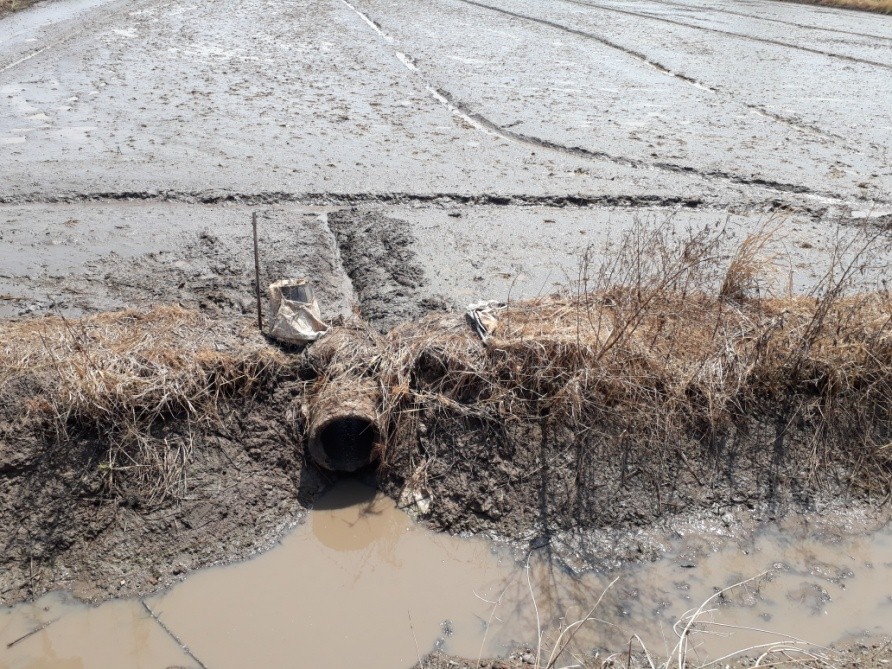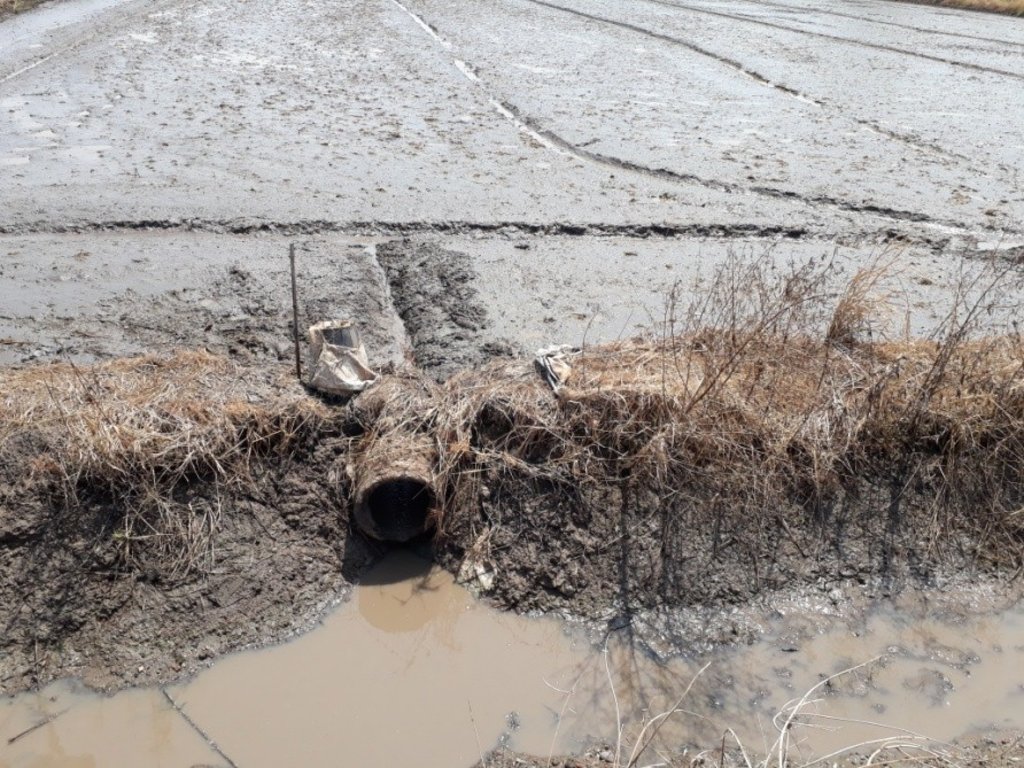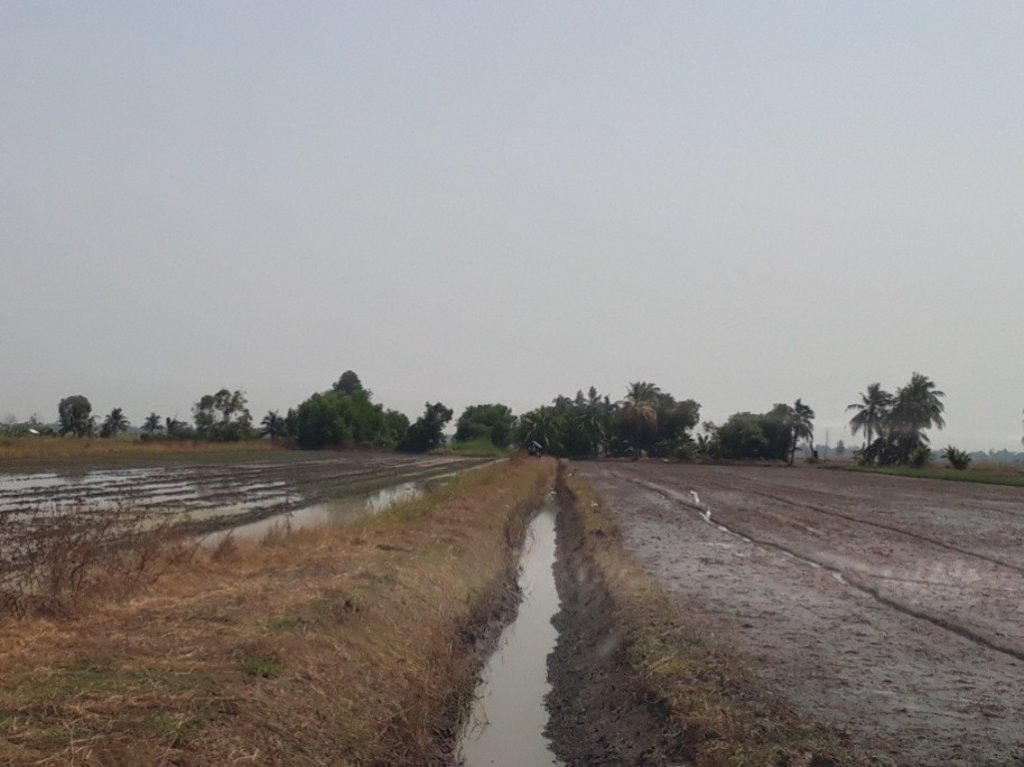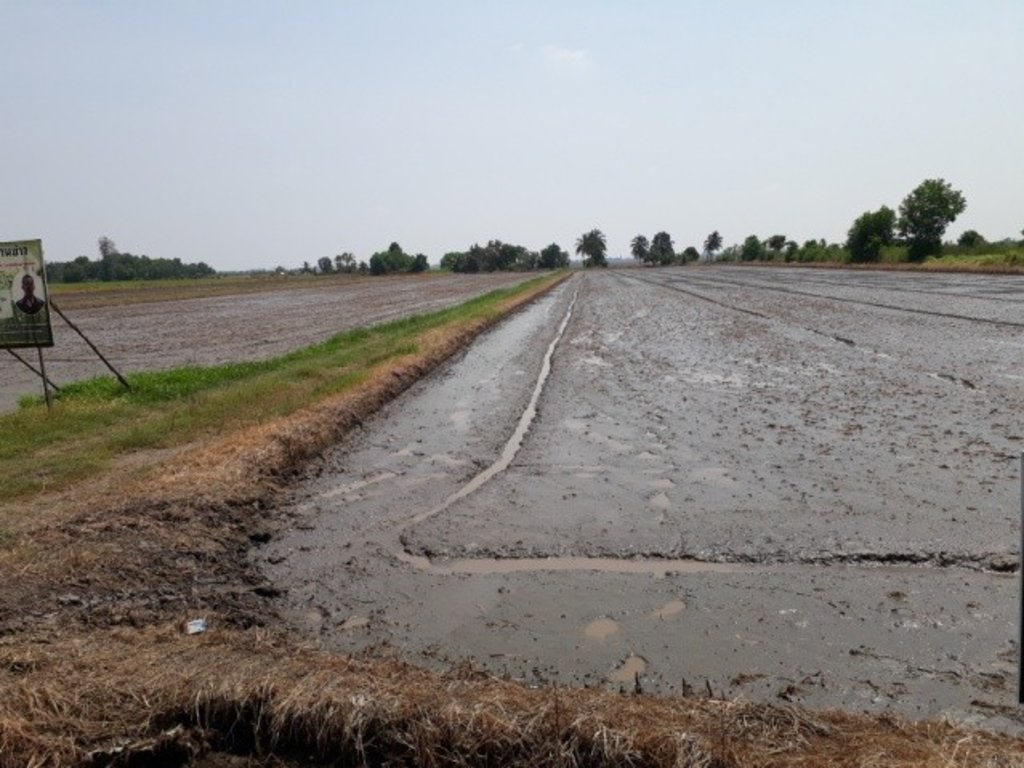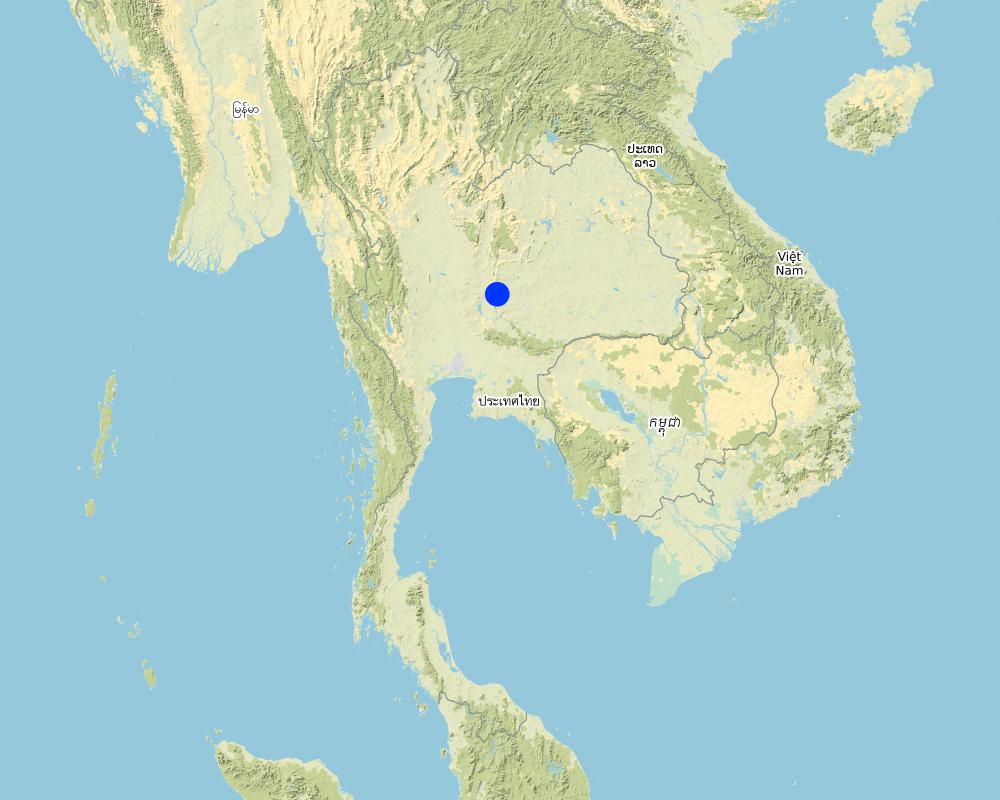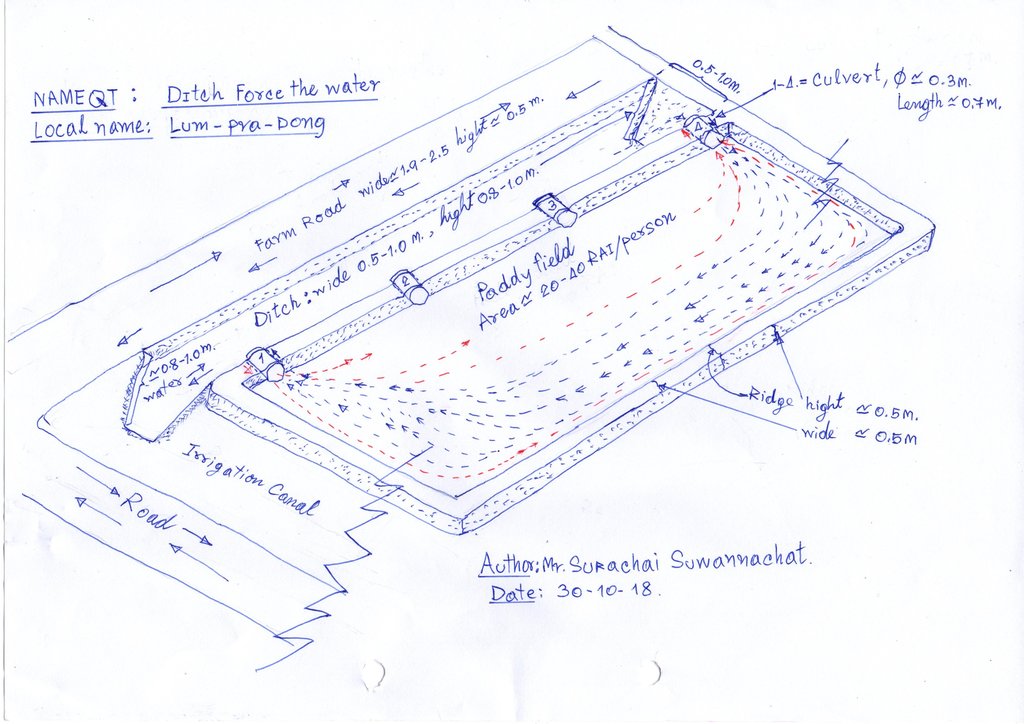Irrigation branch canals in acid sulfate soils [泰国]
- 创建:
- 更新:
- 编制者: Bunjirtluk Jintaridth
- 编辑者: –
- 审查者: Rima Mekdaschi Studer, Pitayakon Limtong, William Critchley
-
technologies_4223 - 泰国
查看章节
全部展开 全部收起1. 一般信息
1.2 参与该技术评估和文件编制的资源人员和机构的联系方式
关键资源人
土地使用者:
1.3 关于使用通过WOCAT记录的数据的条件
编制者和关键资源人员接受有关使用通过WOCAT记录数据的条件。:
是
1.4 所述技术的可持续性声明
这里所描述的技术在土地退化方面是否存在问题,导致无法被认为是一种可持续的土地管理技术?:
否
2. SLM技术的说明
2.1 技术简介
技术定义:
1.To use water in branch canals to supply irrigation water and alternately to leach soil acidity and reduce expenses in managing soil and water 2. The ditch ridge is used as a pathway for agricultural materials and equipment.
2.2 技术的详细说明
说明:
Establishing the system of water drainage ditches - Lampradong Rongnam (irrigation branch canals) is the technology developed from struggling in managing water and soil for farming before 1993. Learning to modify the system was derived from using the labor required to move pumps and equipment to pump water at various locations. This created an exhausting and time-consuming task. Moreover, land could not be developed and the water could not be controlled as required either. Therefore, setting up a system of irrigation branch canals arose from this. The system was then designed to counter acidity and neutralized it from the soil. As a result, rice could be grown, giving a good yield. At the same time, water could be controlled in rice farming throughout. To set up a ditch-branch watercourse comprises ditches of 50-100 centimetres wide, and 100 centimetres deep. Both sides of the ditch consist of ridges that can be modified -either side- to be a path to deliver materials and equipment in doing rice farming and productivity form the paddy. The path to convey materials is 1.9 -2.5 meters up, depending the objectives of the owner of the area. For the levee on the other side, it is 50-100 centimetres wide with a height of 50 centimetres. In the rice farming area of farmers in Ongkharak district, Nakhon Nayok province, there are paddy areas divided into plots. Each plot has an area of 3.2-6.4 hectares. The areas required to establish these canals are about 1,640-3,200 square meters. Farmers not only prefer this adapted technology but it also reduces labour in managing rice farming.
2.3 技术照片
2.5 已应用该技术的、本评估所涵盖的国家/地区/地点
国家:
泰国
区域/州/省:
Nakhon Nayok
有关地点的进一步说明:
Ongkharak district
技术现场是否位于永久保护区?:
否
Map
×2.6 实施日期
如果不知道确切的年份,请说明大概的日期:
- 10-50年前
2.7 技术介绍
详细说明该技术是如何引入的:
- 通过土地使用者的创新
注释(项目类型等):
Establishing the system of irrigation branch canals Lampradong Rongnam is the technology developed from struggling in managing water and soil for doing farming in 1993.
3. SLM技术的分类
3.1 该技术的主要目的
- 改良生产
- 减少、预防、恢复土地退化
- 保护生态系统
- 创造有益的经济影响
- 创造有益的社会影响
3.2 应用该技术的当前土地利用类型
同一土地单元内混合使用的土地::
否

农田
- 一年一作
年作 - 具体指明作物:
- 谷类 - 水稻(湿地)
每年的生长季节数:
- 2
采用间作制度了吗?:
否
采用轮作制度了吗?:
否

水道、水体、湿地
- 排水管道、水道
主要产品/服务:
To control the water level when operating rice farming, and the wide ridge is used to transport agricultural materials and equipment, and to manage farm operations conveniently and quickly.
3.3 由于技术的实施,土地使用是否发生了变化?
由于技术的实施,土地使用是否发生了变化?:
- 否(继续问题3.4)
3.4 供水
该技术所应用土地的供水:
- 充分灌溉
3.5 该技术所属的SLM组
- 灌溉管理(包括供水、排水)
- 湿地保护/管理
3.6 包含该技术的可持续土地管理措施

结构措施
- S3:分级沟渠、渠道、水道
- S7:集水/供水/灌溉设备
- S10:节能措施

管理措施
- M4:活动时间安排的重大变化
3.7 该技术强调的主要土地退化类型

化学性土壤退化
- Ca:酸化
3.8 防止、减少或恢复土地退化
具体数量名该技术与土地退化有关的目标:
- 减少土地退化
4. 技术规范、实施活动、投入和成本
4.1 该技术的技术图纸
技术规范(与技术图纸相关):
Water-directing ditches-Lampradong Rongnam (irrigation branch canals-watercourse)
作者:
Mr. Surachai Suwannachart
日期:
12/11/2018
4.2 有关投入和成本计算的一般信息
具体说明成本和投入是如何计算的:
- 每个技术区域
注明尺寸和面积单位:
1-2 ha
具体说明成本计算所用货币:
- 美元
注明雇用劳工的每日平均工资成本:
10
4.3 技术建立活动
| 活动 | 时间(季度) | |
|---|---|---|
| 1. | Plowing | before on-set of rains |
| 2. | pumping water in the paddy field | before on-set of rains |
| 3. | making soil to become muddy | before on-set of rains |
| 4. | sowing rice seeds | before on-set of rains |
| 5. | pumping water out | before on-set of rains |
| 6. | pumping water in | before on-set of rains |
4.4 技术建立所需要的费用和投入
| 对投入进行具体说明 | 单位 | 数量 | 单位成本 | 每项投入的总成本 | 土地使用者承担的成本% | |
|---|---|---|---|---|---|---|
| 劳动力 | Cost of drilling and the equipment of the water-delivery ditch | person-days | 1.0 | 183.0 | 183.0 | 100.0 |
| 劳动力 | Cost of dredging once per 3-5 years, each time costs | person-days | 1.0 | 166.0 | 166.0 | 100.0 |
| 设备 | oil used in harvesting | hectare | 1.0 | 3.5 | 3.5 | 100.0 |
| 植物材料 | sowing rice seeds | hectare | 1.0 | 0.6 | 0.6 | 100.0 |
| 植物材料 | harvesting | hectare | 1.0 | 3.2 | 3.2 | 100.0 |
| 植物材料 | transporting paddy | hectare | 1.0 | 1.25 | 1.25 | 100.0 |
| 肥料和杀菌剂 | applying fertilizers | hectare | 1.0 | 0.625 | 0.63 | 100.0 |
| 肥料和杀菌剂 | spraying chemicals | hectare | 1.0 | 3.4 | 3.4 | 100.0 |
| 肥料和杀菌剂 | oil used in pumping water into the paddy | hectare | 1.0 | 0.15 | 0.15 | 100.0 |
| 施工材料 | plowing | hectare | 1.0 | 1.56 | 1.56 | 100.0 |
| 施工材料 | pumping water in the paddy field | hectare | 1.0 | 0.15 | 0.15 | 100.0 |
| 施工材料 | making soil become muddy | hectare | 1.0 | 0.156 | 0.16 | 100.0 |
| 施工材料 | pumping water in | hectare | 1.0 | 0.15 | 0.15 | 100.0 |
| 施工材料 | pumping water out | hectare | 1.0 | 0.15 | 0.15 | 100.0 |
| 技术建立所需总成本 | 363.9 | |||||
| 技术建立总成本,美元 | 363.9 | |||||
注释:
Not subsidised
4.5 维护/经常性活动
| 活动 | 时间/频率 | |
|---|---|---|
| 1. | Annual maintenance | 1 |
注释:
cost per 3 years
4.6 维护/经常性活动所需要的费用和投入(每年)
| 对投入进行具体说明 | 单位 | 数量 | 单位成本 | 每项投入的总成本 | 土地使用者承担的成本% | |
|---|---|---|---|---|---|---|
| 劳动力 | Annual cost of maintenance | person-days | 1.0 | 33.0 | 33.0 | 100.0 |
| 技术维护所需总成本 | 33.0 | |||||
| 技术维护总成本,美元 | 33.0 | |||||
4.7 影响成本的最重要因素
描述影响成本的最决定性因素:
current labor costs
5. 自然和人文环境
5.1 气候
年降雨量
- < 250毫米
- 251-500毫米
- 501-750毫米
- 751-1,000毫米
- 1,001-1,500毫米
- 1,501-2,000毫米
- 2,001-3,000毫米
- 3,001-4,000毫米
- > 4,000毫米
农业气候带
- 半湿润
5.2 地形
平均坡度:
- 水平(0-2%)
- 缓降(3-5%)
- 平缓(6-10%)
- 滚坡(11-15%)
- 崎岖(16-30%)
- 陡峭(31-60%)
- 非常陡峭(>60%)
地形:
- 高原/平原
- 山脊
- 山坡
- 山地斜坡
- 麓坡
- 谷底
垂直分布带:
- 0-100 m a.s.l.
- 101-500 m a.s.l.
- 501-1,000 m a.s.l.
- 1,001-1,500 m a.s.l.
- 1,501-2,000 m a.s.l.
- 2,001-2,500 m a.s.l.
- 2,501-3,000 m a.s.l.
- 3,001-4,000 m a.s.l.
- > 4,000 m a.s.l.
5.3 土壤
平均土层深度:
- 非常浅(0-20厘米)
- 浅(21-50厘米)
- 中等深度(51-80厘米)
- 深(81-120厘米)
- 非常深(> 120厘米)
土壤质地(表土):
- 中粒(壤土、粉土)
土壤质地(地表以下> 20厘米):
- 中粒(壤土、粉土)
表土有机质:
- 高(>3%)
5.4 水资源可用性和质量
地下水位表:
5-50米
地表水的可用性:
好
水质(未处理):
仅供农业使用(灌溉)
水质请参考::
地表水
水的盐度有问题吗?:
否
该区域正在发生洪水吗?:
是
5.5 生物多样性
物种多样性:
- 中等
栖息地多样性:
- 中等
5.6 应用该技术的土地使用者的特征
定栖或游牧:
- 定栖的
生产系统的市场定位:
- 生计(自给)
非农收入:
- 低于全部收入的10%
相对财富水平:
- 平均水平
个人或集体:
- 个人/家庭
机械化水平:
- 机械化/电动
性别:
- 男人
土地使用者的年龄:
- 中年人
5.7 应用该技术的土地使用者使用的平均土地面积
- < 0.5 公顷
- 0.5-1 公顷
- 1-2 公顷
- 2-5公顷
- 5-15公顷
- 15-50公顷
- 50-100公顷
- 100-500公顷
- 500-1,000公顷
- 1,000-10,000公顷
- > 10,000公顷
这被认为是小规模、中规模还是大规模的(参照当地实际情况)?:
- 中等规模的
5.8 土地所有权、土地使用权和水使用权
土地所有权:
- 个人,有命名
土地使用权:
- 个人
用水权:
- 个人
土地使用权是否基于传统的法律制度?:
是
5.9 进入服务和基础设施的通道
健康:
- 贫瘠
- 适度的
- 好
教育:
- 贫瘠
- 适度的
- 好
技术援助:
- 贫瘠
- 适度的
- 好
就业(例如非农):
- 贫瘠
- 适度的
- 好
市场:
- 贫瘠
- 适度的
- 好
能源:
- 贫瘠
- 适度的
- 好
道路和交通:
- 贫瘠
- 适度的
- 好
饮用水和卫生设施:
- 贫瘠
- 适度的
- 好
金融服务:
- 贫瘠
- 适度的
- 好
6. 影响和结论性说明
6.1 该技术的现场影响
社会经济效应
生产
作物生产
SLM之前的数量:
2.8 tons per ha
SLM之后的数量:
7.5 tons per ha
生产区域
土地管理
能源生产
注释/具体说明:
Reduced pumping required
水资源可用性和质量
灌溉用水的可用性
社会文化影响
食品安全/自给自足
健康状况
社区机构
SLM/土地退化知识
社会经济弱势群体的情况
生态影响
土壤
土壤水分
酸度
6.2 该技术的场外影响已经显现
水资源可用性
旱季稳定可靠的水流
下游洪水
下游淤积
缓冲/过滤能力
风力搬运沉积物
6.3 技术对渐变气候以及与气候相关的极端情况/灾害的暴露和敏感性(土地使用者认为的极端情况/灾害)
其他气候相关的后果
其他气候相关的后果
| 该技术是如何应对的? | |
|---|---|
| 延长生长期 | 适度 |
| 海平面上升 | 未知 |
6.4 成本效益分析
技术收益与技术建立成本相比如何(从土地使用者的角度看)?
短期回报:
积极
长期回报:
积极
技术收益与技术维护成本/经常性成本相比如何(从土地使用者的角度看)?
短期回报:
积极
长期回报:
积极
6.5 技术采用
- > 50%
在所有采用这项技术的人当中,有多少人是自发的,即未获得任何物质奖励/付款?:
- 91-100%
6.6 适应
最近是否对该技术进行了修改以适应不断变化的条件?:
是
若是,说明它适应了哪些变化的条件:
- 气候变化/极端气候
6.7 该技术的优点/长处/机会
| 土地使用者眼中的长处/优势/机会 |
|---|
| Controlling the acidity or alkalinity of the soil to be at an appropriate level for rice cultivation. |
| Being able to wash off and control acidity/alkalinity of the soil so that it will not cause damages when operating rice farming, whereby rice yield increases. |
| Being able to grow short-lived crops after the rice harvest, which requires some water. |
| 编制者或其他关键资源人员认为的长处/优势/机会 |
|---|
| Reducing expenses, costs. Saving water, fertilizers and chemicals. |
| Reducing the time for transporting materials and equipment, paddy management and transportation of paddy products from the field. |
| Increasing the quantity and quality of farm products. |
| Being able to grow short-lived crops after the rice harvest, which requires some water. |
| Social and cultural aspects such as food security, self-reliance, health, rights to use soil and water, community institutes, knowledge management and promoting capacities, social equality etc. |
| There are good values and cultures toward one another. There is no conflict regarding water because everyone has a ditch in one's own area for every plot. There is food security. They can use the land for rice cultivation more than once a year. |
| There is a water users group and there are organizations that pass on knowledge, conduct training, thus increasing the farmers’ ability in utilizing soil, water and plants. |
6.8 技术的弱点/缺点/风险及其克服方法
| 土地使用者认为的弱点/缺点/风险 | 如何克服它们? |
|---|---|
| There are losing parts of agricultural areas for water delivery ditches construction. | - |
7. 参考和链接
7.1 信息的方法/来源
- 实地考察、实地调查
4
- 与土地使用者的访谈
2
- 与SLM专业人员/专家的访谈
1
- 根据报告和其他现有文档进行编译
1
(现场)数据是什么时候汇编的?:
12/11/2018
7.2 参考可用出版物
标题、作者、年份、ISBN:
the establishment of Lampradong Rongnam-the irrigation ditch (watercourse)
可以从哪里获得?成本如何?
The Learning Center at Village No. 3, Sisa Krabue sub-district, Ongkharak district, Nakhon Nayok
7.3 链接到网络上的相关信息
标题/说明:
the establishment of Lampradong Rongnam-the irrigation ditch (watercourse)
URL:
http:\\www.1ldd.go.th/WEB_PSD/prnew/2561/sr1-61/sr2.pdf
链接和模块
全部展开 全部收起链接
无链接
模块
无模块


